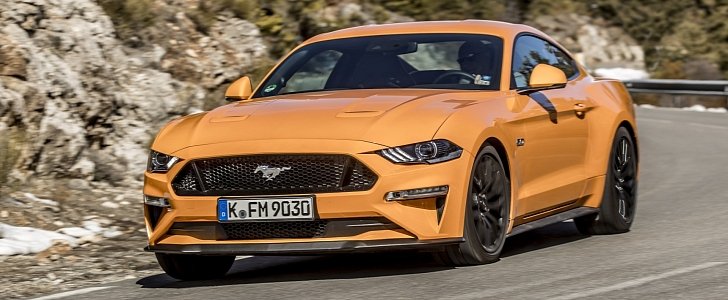More than three years ago, Raj Nair let it slip that the 2020 Ford Mustang Hybrid hides an “EcoBoost-type engine” under the hood. The electrified ‘Stang, however, was pushed back to the S650 program because Jim Hackett wanted to roll out the Mach-E as soon as possible, and this gets us to the 2023 model year.
Sometime in 2022 is when the S650 will start production in Michigan, and the Mustang Hybrid is still on the cards based on the latest hearsay. Adding fuel to the fire, Autocar believes that the Coyote V8 will go hybrid and all-wheel-drive in Europe “to meet stringent fleet average emissions targets.”
That’s somehow strange, and in all likelihood, the rumor is based on a patent filing we’ve covered in January 2019. The question is, what’s wrong with the Mustang Hybrid going V8 instead of EcoBoost-type engine, likely a V6?
For starters, Autocar made the assumption that the ‘Stang is going hybrid because it’s supposed to borrow the CD6 vehicle architecture from the Ford Explorer and Lincoln Aviator. Both mid-size SUVs are available as hybrids and plug-in hybrids, but there’s a big difference between the hybrid V8 patent mentioned in the previous paragraph and the electrified utility vehicles.
Both the Explorer and Aviator sandwich the e-motor between the torque converter and gearbox for regenerative braking and electric drive. That’s not an e-AWD setup as the British motoring publication suggests for the S650, and looking at the bigger picture, e-AWD is the more expensive way to go.
Adding an e-motor to the front axle is pretty much impossible given the size of the Coyote V8 and the available space in the engine bay. However, Ford could only pull it off by integrating two electric motors in each of the front wheels or by mounting the e-motors on either side of the oil pan.
It’s also worth highlighting that the 3.0-liter EcoBoost V6 as a hybrid is more efficient than the 5.0-liter Coyote V8 as a hybrid, with or without e-AWD. The Aviator for the U.S. market, for example, averages 23 miles to the gallon on the combined driving cycle as a hybrid while the ICE-only version tops 20.
Whatever the future holds for the S650 and the Mustang’s electrification strategy, don’t forget that 2022 is the first year of production for the seventh generation. Official confirmation came in February 2020 with a job listing for the Gen 7 program, stating clearly that we’re dealing with a 2023 model.
That’s somehow strange, and in all likelihood, the rumor is based on a patent filing we’ve covered in January 2019. The question is, what’s wrong with the Mustang Hybrid going V8 instead of EcoBoost-type engine, likely a V6?
For starters, Autocar made the assumption that the ‘Stang is going hybrid because it’s supposed to borrow the CD6 vehicle architecture from the Ford Explorer and Lincoln Aviator. Both mid-size SUVs are available as hybrids and plug-in hybrids, but there’s a big difference between the hybrid V8 patent mentioned in the previous paragraph and the electrified utility vehicles.
Both the Explorer and Aviator sandwich the e-motor between the torque converter and gearbox for regenerative braking and electric drive. That’s not an e-AWD setup as the British motoring publication suggests for the S650, and looking at the bigger picture, e-AWD is the more expensive way to go.
Adding an e-motor to the front axle is pretty much impossible given the size of the Coyote V8 and the available space in the engine bay. However, Ford could only pull it off by integrating two electric motors in each of the front wheels or by mounting the e-motors on either side of the oil pan.
It’s also worth highlighting that the 3.0-liter EcoBoost V6 as a hybrid is more efficient than the 5.0-liter Coyote V8 as a hybrid, with or without e-AWD. The Aviator for the U.S. market, for example, averages 23 miles to the gallon on the combined driving cycle as a hybrid while the ICE-only version tops 20.
Whatever the future holds for the S650 and the Mustang’s electrification strategy, don’t forget that 2022 is the first year of production for the seventh generation. Official confirmation came in February 2020 with a job listing for the Gen 7 program, stating clearly that we’re dealing with a 2023 model.







































